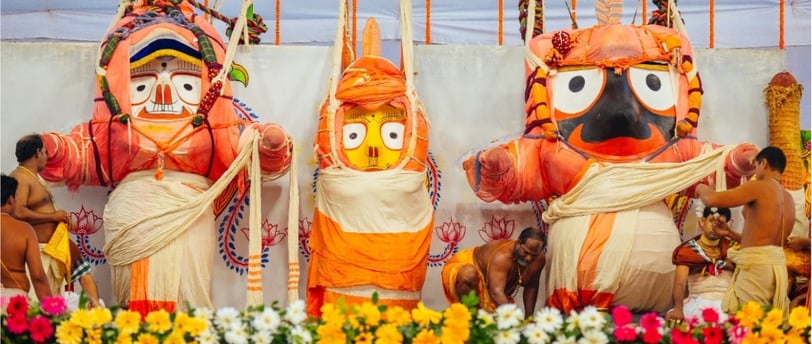SNANA PURNIMA IS A REVERED AND JOYOUS FESTIVAL
Snana Purnima, also known as the Deva Snana Purnima, is a revered and joyous festival that marks a significant day in the traditional Hindu calendar.


Snana Purnima, also known as the Deva Snana Purnima, is a revered and joyous festival that marks a significant day in the traditional Hindu calendar. Celebrated on the full moon day of the Jyeshtha month, it is a day of great importance in the state of Odisha, India, particularly in the holy city of Puri. This festival is deeply intertwined with the worship of Lord Jagannath, a form of Lord Vishnu, and his divine siblings, Lord Balabhadra and Devi Subhadra.
The Snana Purnima is a prelude to the world-famous Rath Yatra, or the Chariot Festival, which occurs just a few weeks later. On this auspicious day, the deities are taken out from the sanctum sanctorum of the Jagannath Temple in a grand procession known as 'Pahandi'. The procession is a vibrant display of devotion, with the air filled with the sounds of mantras, ghantas (bells), drums, bugles, and cymbals. Devotees from all over the country, and even from across the globe, gather in Puri to witness this spiritual event.
Once the deities reach the Snana Bedi, the bathing altar, they are bathed with 108 pitchers of aromatic and herbal-infused water drawn from a sacred well within the temple premises. This ritualistic bathing is not merely a physical cleansing but is symbolic of purifying the soul and the universe. After the bath, the deities are adorned in 'Sada Besha', simple attire that marks their humility. In the afternoon, they are dressed in 'Hathi Besha', resembling Lord Ganesha, symbolizing the removal of obstacles for their devotees.
The Snana Purnima is not just a visual spectacle but also a sensory one, with special bhog (offerings of food) prepared for the deities. The evening allows for 'Sahanamela', a special public viewing where devotees can see the deities up close. However, after this event, the deities are believed to fall ill, entering a period of recuperation called 'Anasara'. During this time, they are not available for public darshan, and instead, paintings of the deities are displayed for worshippers.
The Snana Purnima holds immense religious significance as it is believed that witnessing the bathing ceremony absolves one of all sins. It is a day that reinforces the bond between the divine and the devotee, filled with rituals that date back centuries, yet remain as powerful and relevant today.
The festival is a reminder of the rich cultural tapestry of India and the enduring legacy of its spiritual traditions. As the deities retire to the 'Anasar' house to recuperate, the anticipation for their return and the ensuing Rath Yatra grows, marking another chapter in the cycle of festivities that are central to the worship of Lord Jagannath.


